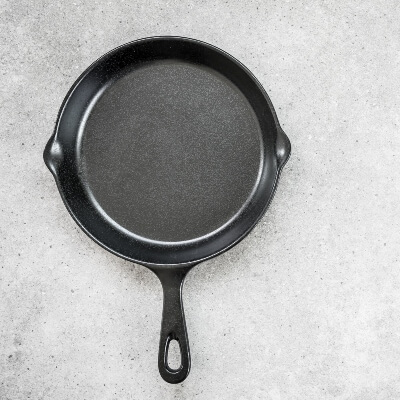
Recently, the stars aligned and we had the rare opportunity where all the kids were out of the house for a night. So I decided to cook for my wife Shawna. Now, when I am focused I am a pretty good cook. The problem is, when the food is cooking I see this as a perfect chance to get other things done. As I motor around the house rapidly getting so many things done, I frequently forget the original task – cooking. You can see where this is going. I put a cutting board over the fry pan where I was sauteing veggies, thinking I would leave it just for a few seconds to build some steam. Well, we have a gas stove and you can imagine what happened next as I scurried around the house and completely forgot about the fry pan and the plastic cutting board that subsequently melted all over the food and the stove.
As it turns out, the frying pan I ruined (cleaning hardened melted plastic off any surface is an arduous task) happened to be that one perfectly sized pan that gets used about 90% of the time in our house. I saw this as an opportunity since I had been wanting to update this pan for quite some time. So I began a deep dive into the current information on which pans are the best and healthiest. Here is what I found out:
When it comes to choosing the right cookware for a healthier kitchen, the materials of your pans play a significant role. Stainless steel and cast iron fry pans offer distinct health benefits, while non-stick pans coated with Teflon (polytetrafluoroethylene or PTFE) have been linked to potential health risks. Understanding the differences between these materials can help you make an informed decision for your cooking needs.
Health Benefits of Stainless Steel Fry Pans
Stainless steel pans are widely praised for their non-reactive nature, making them ideal for cooking acidic foods like tomatoes and citrus without the risk of leaching metals into your meal. This is because stainless steel is made from an alloy of iron, chromium, and nickel, which form a stable, non-toxic surface. Stainless steel pans are also durable, resistant to rust, and can handle high heat, making them safe for a variety of cooking methods, including searing, sautéing, and frying.
Another health benefit of stainless steel is that it requires little maintenance. Unlike cast iron, stainless steel does not require seasoning, and its surface remains non-reactive throughout its lifespan. While food may stick more easily than in a non-stick pan, using healthy oils like olive, coconut, or avocado oil or ghee can mitigate this issue and make for a safe cooking experience. Additionally, stainless steel does not harbor bacteria, making it easy to clean and sanitize, contributing to a hygienic kitchen environment.
Health Benefits of Cast Iron Fry Pans
Cast iron pans, known for their ability to retain and distribute heat evenly, offer unique health benefits, particularly for those who may be iron deficient. A small amount of iron leaches from the pan into the food during cooking, which can help supplement your dietary intake of this essential mineral. This is especially beneficial for individuals at risk of anemia.
One key feature of cast iron is its natural non-stick surface that develops over time through seasoning. Seasoning involves coating the pan with oil and heating it, creating a polymerized layer that prevents food from sticking and eliminates the need for chemical coatings. Cast iron pans are extremely durable, and when properly maintained, they can last for generations. However, cast iron requires more upkeep than stainless steel, including regular seasoning and careful drying to prevent rust.
The Dangers of Teflon Coating (PTFE)
Non-stick pans with Teflon coating are popular for their convenience, allowing for easy food release and minimal oil use. However, they come with potential health hazards. Teflon is made from PTFE, a chemical that can start to break down and release toxic fumes when heated above 500°F (260°C). These fumes can cause “Teflon flu” (polymer fume fever), which produces flu-like symptoms in humans. More concerning is the potential release of perfluorooctanoic acid (PFOA), a chemical once used in the production of Teflon that has been linked to cancer, thyroid disorders, and other health issues.
While manufacturers have largely phased out PFOA since 2013, concerns about the safety of Teflon-coated pans persist, particularly when the coating is scratched or worn. Cooking at lower temperatures and using proper utensils can reduce the risk, but it’s worth considering alternatives if long-term health is a priority. Now would be a great time to update your old Teflon cookware – put it on your Christmas list!
Conclusion
We rid our house of Teflon many years ago due to the health hazards so my decision was really between stainless and cast iron. The convenience of stainless steel (the fact that it could be left to air dry in the sink after washing) won out over the nostalgia of the cast iron. We have a solid cast iron fry pan to use on occasions but for the daily workhorse fry pan – we chose a stainless steel Lagostina fry pan that can be placed right in the oven if needed.
I hope that is helpful.
In good health,
Dr Craig
CONTACT US
